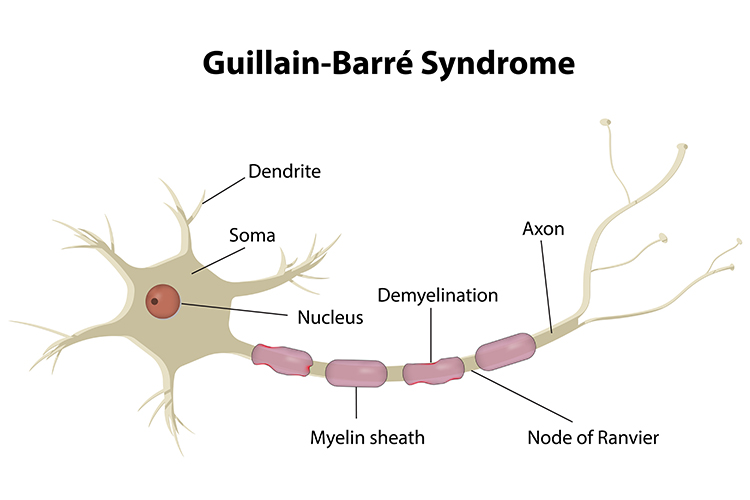Allergies & Immunology
Guillain-Barré Syndrome
By D.A. (staff writer) , published on October 17, 2020

Medicine Telehealth Health Guillian-Barre Syndrome Immunity Immune system immune system disorder
Guillain-Barré syndrome
Guillain-Barre syndrome is a rare disorder in which your body's immune system attacks your nerves. Weakness and tingling in your extremities are usually the first symptoms.
These sensations can quickly spread, eventually paralyzing your whole body. In its most severe form, Guillain-Barre syndrome is a medical emergency. Most people with the condition must be hospitalized to receive treatment.
Symptoms
Guillain-Barre syndrome often begins with tingling and weakness starting in your feet and legs and spreading to your upper body and arms. In about 10% of people with the disorder, symptoms begin in the arms or face. As Guillain-Barre syndrome progresses, muscle weakness can evolve into paralysis.
Signs and symptoms of Guillain-Barre syndrome may include:
- Prickling, pins and needles sensations in your fingers, toes, ankles or wrists
- Weakness in your legs that spreads to your upper body
- Unsteady walking or inability to walk or climb stairs
- Difficulty with facial movements, including speaking, chewing or swallowing
- Double vision or inability to move eyes
- Severe pain that may feel achy, shooting or cramplike and may be worse at night
- Difficulty with bladder control or bowel function
- Rapid heart rate
- Low or high blood pressure
- Difficulty breathing
What happens in GBS?
Many of the body’s nerves are like household wires. There is a central conducting core in the nerves called the axon that carries an electric signal. The axon (an extension of a nerve cell) is surrounded by a covering, like insulation, called myelin. The myelin sheath surrounding the axon speeds up the transmission of nerve signals and allows the transmission of signals over long distances.
Weakness
When we move, for example, an electric signal from the brain travels through and out of the spinal cord to peripheral nerves along muscles of the legs, arms, and elsewhere—called motor nerves. In most cases of GBS, the immune system damages the myelin sheath that surrounds the axons of many peripheral nerves; however, it also may also damage the axons themselves.
As a result, the nerves cannot transmit signals efficiently and the muscles begin to lose their ability to respond to the brain's commands. This causes weakness.
The weakness seen in GBS usually comes on quickly and worsens over hours or days. Symptoms are usually equal on both sides of the body (called symmetric). In addition to weak limbs, muscles controlling breathing can weaken to the point that the person must be attached to a machine to help support breathing.
Sensation changes
Since nerves are damaged in GBS, the brain may receive abnormal sensory signals from the rest of the body. This results in unexplained, spontaneous sensations, called paresthesias, that may be experienced as tingling, a sense of insects crawling under the skin (called formications), and pain. Deep muscular pain may be experienced in the back and/or legs.
How is Guillain-Barré syndrome diagnosed?
The initial signs and symptoms of GBS are varied and there are several disorders with similar symptoms. Therefore, doctors may find it difficult to diagnose GBS in its earliest stages.
Key diagnostic findings include:
- Recent onset, within days to at most four weeks of symmetric weakness, usually starting in the legs
- Abnormal sensations such as pain, numbness, and tingling in the feet that accompany or even occur before weakness
- Absent or diminished deep tendon reflexes in weak limbs
- Elevated cerebrospinal fluid protein without elevated cell count.This may take up to 10 days from onset of symptoms to develop.
- Abnormal nerve conduction velocity findings, such as slow signal conduction
- Sometimes, a recent viral infection or diarrhea.
Practice Essentials
Guillain-Barré syndrome (GBS) can be described as a collection of clinical syndromes that manifests as an acute inflammatory polyradiculoneuropathy with resultant weakness and diminished reflexes.
Although the classic description of GBS is that of a demyelinating neuropathy with ascending weakness, many clinical variants have been well documented in the medical literature.
References
“Guillain-Barre Syndrome - Symptoms and Causes.” n.d. Mayo Clinic. Accessed October 17, 2020. https://www.mayoclinic.org/diseases-conditions/guillain-barre-syndrome/symptoms-causes/syc-20362793.
“Guillain-Barré Syndrome Fact Sheet | National Institute of Neurological Disorders and Stroke.” n.d. Accessed October 17, 2020. https://www.ninds.nih.gov/Disorders/Patient-Caregiver-Education/Fact-Sheets/Guillain-Barr%C3%A9-Syndrome-Fact-Sheet.
“Guillain-Barre Syndrome: Practice Essentials, Background, Pathophysiology.” 2020, June. https://emedicine.medscape.com/article/315632-overview.
Find articles related to: Medicine Telehealth Health Guillian-Barre Syndrome Immunity Immune system immune system disorder
More articles about Allergies & Immunology
Back to the Health Tips Index




